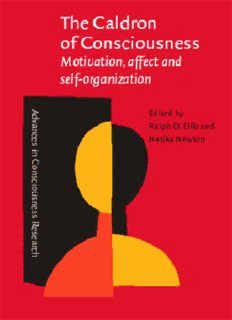
the caldron of consciousness: motivation, affect and self-organization PDF
Preview the caldron of consciousness: motivation, affect and self-organization
THE CALDRON OF CONSCIOUSNESS ADVANCES IN CONSCIOUSNESS RESEARCH ADVANCES IN CONSCIOUSNESS RESEARCH provides a forum for scholars from different scientific disciplines and fields of knowledge who study conscious- ness in its multifaceted aspects. Thus the Series will include (but not be limited to) the various areas of cognitive science, including cognitive psychology, linguistics, brain science and philosophy. The orientation of the Series is toward developing new interdisciplinary and integrative approaches for the investigation, description and theory of consciousness, as well as the practical consequences of this research for the individual and society. Series B: Research in Progress. Experimental, descriptive and clinical research in consciousness. EDITOR Maxim I. Stamenov (Bulgarian Academy of Sciences) EDITORIAL BOARD David Chalmers (University of Arizona) Gordon G. Globus (University of California at Irvine) Ray Jackendoff (Brandeis University) Christof Koch (California Institute of Technology) Stephen Kosslyn (Harvard University) Earl Mac Cormac (Duke University) George Mandler (University of California at San Diego) John R. Searle (University of California at Berkeley) Petra Stoerig (Universität Düsseldorf) Francisco Varela (C.R.E.A., Ecole Polytechnique, Paris) Volume 16 Ralph D. Ellis and Natika Newton (eds) The Caldron of Consciousness Motivation, affect and self-organization – An anthology THE CALDRON OF CONSCIOUSNESS MOTIVATION, AFFECT AND SELF-ORGANIZATION – AN ANTHOLOGY Edited by RALPH D. ELLIS Clark Atlanta University NATIKA NEWTON Nassau Community College JOHN BENJAMINS PUBLISHING COMPANY AMSTERDAM/PHILADELPHIA TM The paper used in this publication meets the minimum requirements of 8 American National Standard for Information Sciences — Permanence of Paper for Printed Library Materials, ansi z39.48–1984. Library of Congress Cataloging-in-Publication Data The caldron of consciousness : motivation, affect and self-organization -- an anthology / edited by Ralph D. Ellis, Natika Newton. p. cm. -- (Advances in consciousness research, ISSN 1381-589X ; v. 16) Includes bibliographical references and index. 1. Consciousness. 2. Emotions 3. Motivation (Psychology) . 4. Self-organizing systems. I. Ellis, Ralph D. II. Newton, Natika III. Series. BF311.C148 2000 153--dc21 00-033720 ISBN 90 272 5136 3 (Eur.) / 1 55619 196 0 (US) (Pbk.) © 2000 – John Benjamins B.V. No part of this book may be reproduced in any form, by print, photoprint, microfilm, or any other means, without written permission from the publisher. John Benjamins Publishing Co. • P.O.Box 75577 • 1070 AN Amsterdam • The Netherlands John Benjamins North America • P.O.Box 27519 • Philadelphia PA 19118-0519 • USA Table of Contents List of Contributors vii Introduction ix P I TheCentralityofEmotion 1. Integrating the Physiological and Phenomenological Dimensions of Affect and Motivation 3 RalphD.Ellis 2. Affective Consciousness and the Instinctual Motor System: The Neural Sources of Sadness and Joy 27 JaakPanksepp 3. Consciousness, Motivation, and Emotion: Biopsychological Reflections 55 BillFaw 4. Conscious Emotion in a Dynamic System: How I Can Know How I Feel 91 NatikaNewton P II TowardanEcologicalScienceoftheAffectiveSphere 5. The ‘Mind’/‘Body’ Problem and First-Person Process 109 EugeneT.Gendlin 6. Dissolving Differences: How to Understand the Competing Approaches to Human Emotion 119 ValerieGrayHardcastle vi TABLEOFCONTENTS 7. The Effect of Motivation on the Stream of Consciousness: Generalizing from a Neurocomputational Model of Cingulo-frontal Circuits Controlling Saccadic Eye Movements 133 MaricaBernstein,SamanthaStiehlandJohnBickle 8. Motivation and Emotion: An Interactive Process Model 161 MarkH.Bickhard 9. Mind, Brain, and Chaos 179 NicholasGeorgalis P III EmotionalLearningandDevelopment 10. Child Development and the Regulation of Affect and Cognition in Consciousness: A View from Object Relations Theory 205 PeterZachar 11. Emotions: The Fetters of Instincts and the Promise of Dynamic Systems 223 GaryBackhaus 12. Awareness of Emotions: A Neuropsychological Perspective 243 M.Peper Index 271 List of Contributors GaryBackhaus BillFaw MorganStateUniversity BrewtonParkerCollege DepartmentofPhilosophy PsychologyDepartment BALTIMORE,MD21209 MT.VERNON,GA30445 USA USA MaricaBernstein EugeneT.Gendlin EastCarolinaUniversity TheUniversityofChicago BrodySchoolofMedicine DepartmentofPsychology DepartmentofPhysiology 5848S.UniversityAve. GREENVILLE,NC27858–4353 CHICAGO,IL60637–1584 USA USA MarkH.Bickhard NicholasGeorgalis CognitiveScience EastCarolinaUniversity LehighUniversity DepartmentofPhilosophy 17,MemorialDriveEast GREENVILLE,NC27858–4353 BETHLEHEM,PA18015–3068 USA USA JohnBickle ValerieGrayHardcastle EastCarolinaUniversity DepartmentofPhilosophy Dept.ofPhilosophyandProgramin VirginiaPolytechnicInst.andState Neuroscience University GREENVILLE,NC27858–4353 BLACKSBURG,VA24061–0126 USA USA RalphD.Ellis NatikaNewton ClarkAtlantaUniversity, NassauComm.College Dept.ofReligionandPhilosophy PhilosophyDepartment 223JamesP.BrawleyDriveatFair GARDENCITY,NY11530 St.SW USA P.O.Box81 ATLANTA,GA30314 USA viii LISTOFCONTRIBUTORS JaakPanksepp SamanthaStiehl BowlingGreenStateUniversity UniversityofRochester Dept.ofPsychology CenterforVisualScience MemorialFoundationforLost Dept.ofBrain&CognitiveScience Children ROCHESTER,NY14627 BOWLINGGREEN,OH43403 USA USA PeterZachar MartinPeper AuburnUniversityMontgomery UniversityofFreiburg DepartmentofPsychology DepartmentofPsychology MONTGOMERY,AL36124 Niemensstr.10 USA D79085FREIBURG Germany Introduction Cognitive scientists are just beginning to pay attention to motivation and emotion,along-neglecteddimensionofconsciousness.Theattentionbeganwith the work of neurophysiologists such as Damasio, Luria, Posner, Pribram, and LeDoux, and the subject is still strongly associated with the neurosciences (for example,theAssociationfortheScientificStudyofConsciousnesshassponsored anelectronicseminaron“ConsciousnessandEmotion,”http://www.phil.vt.edu/- ASSC/esem). Thisscientificinterestinthestudyofmotivationandemotioninconscious- ness may lead to more efficient and fruitful projects than those associated with the exploration of consciousness as a mere appendage to the more traditionally understoodareasofinformationprocessing,perception,andintellectualcognition. The role of consciousness was relegated primarily to philosophy for several decadesbeforetheseminalworkofCrickandKochinthe1990s(e.g.,seeCrick and Koch 1990). Now consciousness is the center of a major multidisciplinary program, which has in turn brought emotion into the spotlight. Ourgoalinthisanthologyistobringtogetherthinkersinvariousdisciplines who are in the vanguard of emotion studies — including physiological, psycho- logicalandphilosophical approachesto motivation andall the affectiveprocess- es — with the goal of providing a coherent multidisciplinary framework for understanding emotion and its contribution to the workings of consciousness in general. The organizing premise of this volume is that consciousness and emotion are aspects of the embodied subject as a self-organizing system. Understanding the role of emotion and motivation in a self-organizing process requires approaching it via philosophy, neuroscience, and psychology (both theoretical and clinical). This anthology includes prominent researchers in all of theseareas.Because ofthe commonthemeof self-organization,the contributors do not talk past each other, but share a general view of consciousness and emotion as processes with central roles in maintaining the well-being of the organism. We believe that such an approach, which coordinates multiple viewpoints within a central framework, is essential to real progress in under- standing emotion and consciousness.
Description: